What is Catnip?
Catnip is an herbaceous plant that belongs to the mint family Lamiaceae. Its botanical name is Nepeta cataria. Catnip is a perennial herb with toothed, heart-shaped leaves and small, white tubular flowers that bloom from late spring to fall.[1]
The active chemical compound in catnip that attracts cats is called nepetalactone. This volatile oil is present in the leaves and stems of catnip plants. When cats smell nepetalactone, it binds to receptors in their nose and has a stimulating and euphoric effect.
Sniffing or eating catnip causes a range of temporary effects in cats like apparent euphoria, rolling around, drooling, aggression, and anxiety reduction. The effects of catnip on cats are inherited and not all cats are affected by it. Kittens younger than eight weeks old also typically do not respond to catnip.[2]
[1] https://hort.extension.wisc.edu/articles/catnip-nepeta-cataria/

[2] https://bonnieplants.com/blogs/how-to-grow/growing-catnip
Does Catnip Affect Dogs?
Catnip contains a chemical called nepetalactone which is what causes the intoxicating effects in cats. However, dogs lack the receptors affected by nepetalactone (1). This means catnip has no intoxicating effects on dogs like it does for cats.
Some dogs may show mild interest in catnip or even eat catnip toys, but most show no response at all. Catnip simply does not produce the same chemical reaction in dogs as it does in cats (2).
While a small minority of dogs may show some mild exhilaration from catnip, the effect is nowhere near the level seen in cats. Dog owners should not expect their pets to act “high” or have any type of significant reaction to catnip (3). The chemical that makes catnip intoxicating for cats is simply not bioactive in canines.
So in summary, while catnip stimulates cats, it generally does not have any major effect on dogs.
(1) https://www.dailypaws.com/dogs-puppies/dog-safety-tips/catnip-for-dogs
(2) https://blog.healthypawspetinsurance.com/is-catnip-safe-for-dogs
(3) https://sports.yahoo.com/catnip-dogs-safe-vet-explains-232722783.html
Is Catnip Safe for Dogs?
Yes, catnip is generally considered safe for dogs. According to Rover’s veterinary review board, catnip contains essential vitamins and nutrients that are actually beneficial for dogs, when given in moderation [1]. The active chemical compound in catnip, called nepetalactone, does not have any dangerous or concerning side effects for canine health.

While catnip stimulates cats, it typically has a sedative effect on dogs. So there is no risk of your dog becoming hyperactive or overstimulated from catnip exposure. Overall, most veterinarians agree that occasional, moderate catnip use is completely safe for dogs and will not cause any health complications.
Behavioral Effects of Catnip on Dogs
Catnip tends to have very little effect on most dogs. According to the ASPCA[1], only about 20-30% of dogs exposed to catnip will show even mild interest in it. For these dogs, catnip may cause sniffing, licking, chewing, and gentle playfulness. However, catnip does not stimulate dogs the same way it does cats, who may become very excited by the herb.
Some key things to note about catnip’s effects on dog behavior:
- Most dogs are completely unaffected by catnip.
- A small percentage show mild interest, but nothing like the euphoric reaction seen in cats.
- Catnip is unlikely to overstimulate dogs or cause them to become hyperactive.
- The effects last 5-15 minutes, then quickly wear off.
- Catnip should always be given in moderation to avoid overconsumption.
Overall, catnip is not considered stimulatory or addictive for dogs like it is for cats. There is little risk of overstimulation from limited, supervised exposure to catnip.
Using Catnip for Dogs
While catnip can provide some benefits for dogs, the herb does not affect canines in the same intense way as cats. Catnip-stuffed toys tend to be uninteresting for most dogs (source). The aroma from catnip oil in a diffuser is also typically ineffective at relaxing dogs or altering their behavior (source).
Instead of giving dogs toys or treats designed for cats, it’s better to buy products marketed specifically for canine use. Seek out dog toys containing catnip that are designed to hold a dog’s interest. Consider catnip dog treats made with high-quality ingredients. Work with your veterinarian to determine safe dosages and forms of catnip to try with your dog.
Risks of Giving Catnip to Dogs
While catnip is generally safe for most dogs, there are some potential risks to be aware of before giving your dog catnip:

Allergic Reactions – As with any new substance, some dogs may have an allergic reaction to catnip. Signs of an allergic reaction can include irritated skin, diarrhea, vomiting, or trouble breathing. If you notice these signs after exposing your dog to catnip, discontinue use and contact your veterinarian.
Indigestion if Eaten – Catnip is typically given to dogs by rubbing it on toys or bedding. However, some dogs may try to eat catnip. Consuming large amounts can potentially cause indigestion, especially if the catnip contains stalks or stems. It’s best to supervise your dog when first using catnip to prevent overconsumption.
Preexisting Health Conditions – Catnip can act as a stimulant for some dogs. If your dog has any heart, seizure, or anxiety disorders, it’s best to avoid using catnip as it could exacerbate these conditions. Check with your veterinarian before using catnip if your dog has any preexisting health problems.
Overall, catnip is generally benign and non-toxic https://www.rover.com/blog/is-catnip-safe-for-dogs/. But it’s still important to carefully introduce it and monitor your dog’s reaction. Discontinue use if any concerning symptoms develop.
Signs of a Catnip Allergy
Some dogs may have an adverse reaction to catnip. Signs of a catnip allergy in dogs can include:
Itchy skin, hives, swelling – Dogs with a catnip allergy may experience irritation and inflammation of the skin, hives, and swelling around the face, paws or body after exposure to catnip. These are common symptoms of an allergic reaction.
Vomiting, diarrhea – Catnip may cause gastrointestinal distress in some dogs, leading to vomiting and/or diarrhea after ingesting catnip. This reaction indicates the dog’s body is attempting to expel the irritant.
Drowsiness, drooling – Excessive drowsiness and drooling could also be a sign of an adverse reaction to catnip in dogs. The catnip is acting as a sedative rather than a stimulant.
If a dog exhibits any of these allergy symptoms after being exposed to catnip, discontinue use immediately and contact a veterinarian. Never give catnip to a dog that has shown signs of sensitivity.
Catnip Alternatives for Dogs
If catnip doesn’t appeal to you or to your dog, there are some potential alternatives. Some dog owners have had success providing substances other than catnip that create a similar pleasant effect for dogs. Here are some catnip alternatives to consider for dogs:
Toys Filled with Dog-Safe Herbs: Some companies make dog toys filled with relaxing herbs like chamomile and valerian that can have a calming effect on dogs similar to catnip. The scent of these herbs appeals to many dogs. Examples of herb-filled dog toys include the PetSafe Chill Puzzle Treat Dog Toy filled with chamomile and Petstages Dogwood Stick Dog Chew Toy filled with valerian.

Pheromone Diffusers: Rather than herbs, some pet owners use pheromone diffusers designed specifically to have a calming effect on dogs. These release synthetic dog pheromones into the air that can help relax dogs without directly ingesting or smelling anything. Popular pheromone diffuser products include Adaptil and Comfort Zone.
Species-Specific Playtime: Some dogs simply get stimulated and excited from playtime activities specifically tailored to their breed traits and natural instincts. Providing adequate physical and mental stimulation through play can satisfy many dogs’ needs for an uplifting experience similar to what catnip does for cats. Consult dog training experts for creative play ideas suited to your dog’s individual personality.
When to Avoid Catnip for Dogs
Even though catnip is generally safe for dogs, there are some instances where it should be avoided:
Underlying Health Conditions
Dogs with certain health conditions like diabetes, epilepsy, or thyroid disease should not be given catnip, as it can negatively interact with those conditions. Catnip can lower blood sugar, stimulate nerves, and impact hormone levels so is best avoided in dogs with these illnesses.
[source: https://www.rover.com/blog/is-catnip-safe-for-dogs/]
When Used Excessively
While small, occasional amounts of catnip are fine for most dogs, using it excessively can cause negative side effects. Consuming large quantities of catnip may cause vomiting, diarrhea, hyperactivity, agitation or lethargy in some dogs.
[source: https://www.dailypaws.com/dogs-puppies/dog-safety-tips/catnip-for-dogs]
Young Puppies
Catnip should be avoided in very young puppies, as their young immune systems and developing organs may be more sensitive to its effects. Most experts recommend waiting until a dog is at least 6 months old before introducing catnip.
[source: https://www.holistapet.com/blogs/dog-care/is-catnip-bad-for-canines]
Conclusion
In summary, catnip is generally considered safe for dogs but does not produce the same intoxicating effects as it does in cats. While some dogs may show mild behavioral changes when exposed to catnip, most dogs are unaffected or indifferent to the herb. Catnip is not toxic to dogs and ingesting moderate amounts is unlikely to cause harm. However, some dogs may have allergic reactions to catnip, so owners should monitor for adverse effects like itchiness, hives, or gastrointestinal upset.
Rather than using catnip itself, owners looking to enrich their dog’s environment may want to consider dog-specific products made with catnip oil extracts or sprays designed to capture a dog’s interest. Ultimately, catnip itself provides little benefit for most dogs. It’s better to focus on toys, training aids, and chews specifically tailored to stimulate and engage a canine companion.

